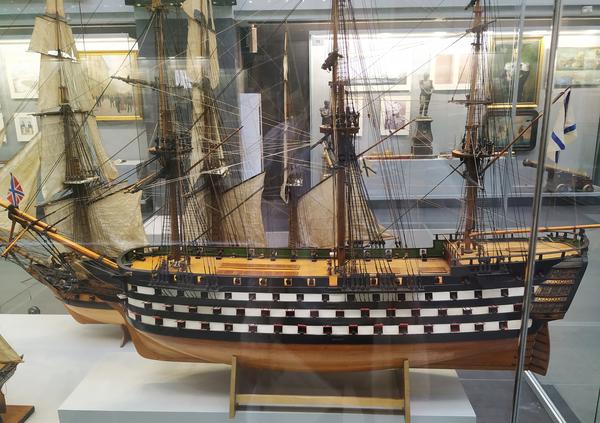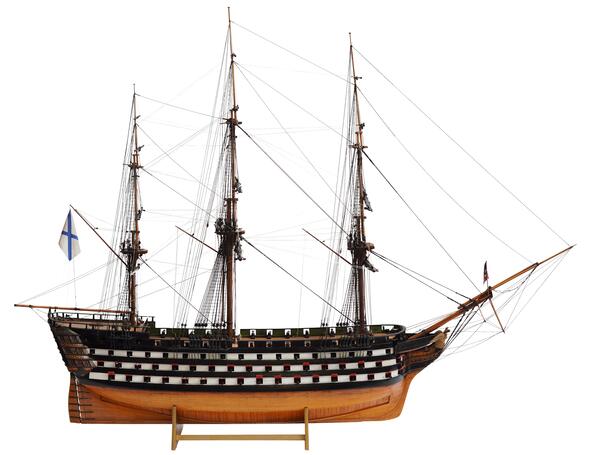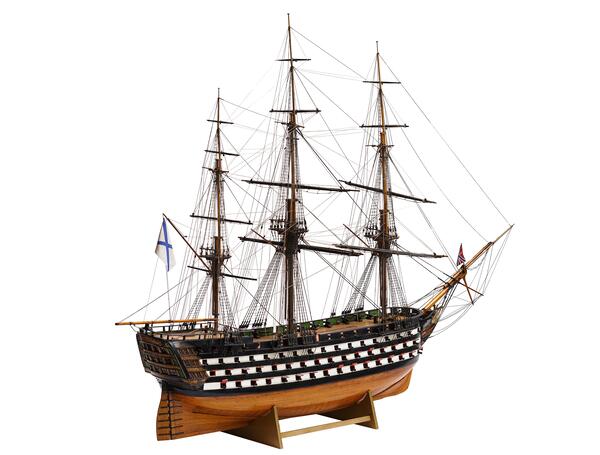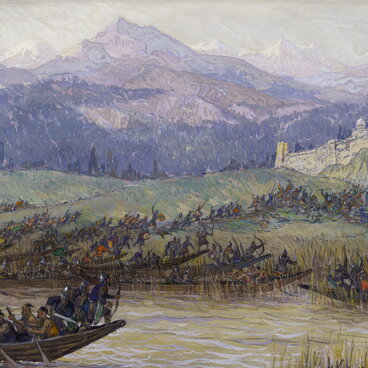The “Rossiya” 120-gun ship was laid down on February 11, 1836 in the New Admiralty Shipyard in Saint Petersburg. The constructor of the ship was Alexander Popov. “Rossiya” was first launched on May 5, 1839 and joined the Baltic Fleet. She displaced 4,904 tons, and had a length of 63.4 m, a width of 17 m, and a depth of hold of 7.7 m. The artillery on all four decks of the ship was represented by 36-pounder guns.
In 1840, “Rossiya” sailed between Kronstadt and Reval, undergoing various tests. Between 1841 and 1853, she was used as part of squadrons in the Baltic Sea and the Gulf of Finland. “Rossiya” sailed to the coast of Denmark and participated in the Baltic Fleet Expedition of 1848–1850. On June 26, 1850, as part of the 3rd division of Vice Admiral Ivan Petrovich Epanchin, the ship sailed from Kronstadt to Denmark. Between July 11 and September 16, 1850, she was on the Sondenburg roadstead and after that returned to Russia.
The “Rossiya” ship took part in the Crimean (Eastern) War of 1853–1856. In 1854 and 1855, as part of the 3rd division of Vice Admiral Yakov Ananyevich Shikhmanov, the ship was on standby in Sveaborg. On July 28, 1855, during the bombardment of Sveaborg by the British and French fleet, the ship maintained its position in the Gustafsvard passage and delivered retaliation fire. During the bombardment of the fortress, 11 members of the crew were killed, and 89 were wounded. The ship suffered 85 shot holes. At night, after the end of the attack, “Rossiya” changed its position. After two days of bombing, the allied fleet withdrew, failing to land and capture Sveaborg.
After 1857, the “Rossiya” 120-gun ship was used as a berthing barge in Sveaborg, and in 1860, it was sold for scrap there. The list of the ship’s commanders includes Alexander Shulepnikov (1840), Lev Karpov (1841), Mikhail Shleyn (1843–1845), Vasily Speyer (1847–1854), and Vasily Poplonsky (1855).
The model of the “Rossiya” ship from the museum’s exhibition is made of painted fine wood and ivory. It belonged to the collection of Grand Duke Alexei Alexandrovich of Russia.
In 1840, “Rossiya” sailed between Kronstadt and Reval, undergoing various tests. Between 1841 and 1853, she was used as part of squadrons in the Baltic Sea and the Gulf of Finland. “Rossiya” sailed to the coast of Denmark and participated in the Baltic Fleet Expedition of 1848–1850. On June 26, 1850, as part of the 3rd division of Vice Admiral Ivan Petrovich Epanchin, the ship sailed from Kronstadt to Denmark. Between July 11 and September 16, 1850, she was on the Sondenburg roadstead and after that returned to Russia.
The “Rossiya” ship took part in the Crimean (Eastern) War of 1853–1856. In 1854 and 1855, as part of the 3rd division of Vice Admiral Yakov Ananyevich Shikhmanov, the ship was on standby in Sveaborg. On July 28, 1855, during the bombardment of Sveaborg by the British and French fleet, the ship maintained its position in the Gustafsvard passage and delivered retaliation fire. During the bombardment of the fortress, 11 members of the crew were killed, and 89 were wounded. The ship suffered 85 shot holes. At night, after the end of the attack, “Rossiya” changed its position. After two days of bombing, the allied fleet withdrew, failing to land and capture Sveaborg.
After 1857, the “Rossiya” 120-gun ship was used as a berthing barge in Sveaborg, and in 1860, it was sold for scrap there. The list of the ship’s commanders includes Alexander Shulepnikov (1840), Lev Karpov (1841), Mikhail Shleyn (1843–1845), Vasily Speyer (1847–1854), and Vasily Poplonsky (1855).
The model of the “Rossiya” ship from the museum’s exhibition is made of painted fine wood and ivory. It belonged to the collection of Grand Duke Alexei Alexandrovich of Russia.





